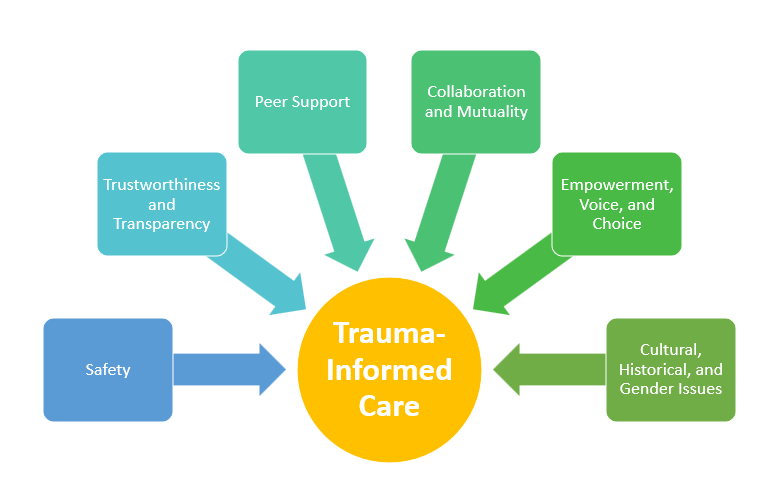Introduction
Trauma. The word seems to pop up everywhere these days, from TikTok rants about “trauma bonding” to sitcom characters hilariously attributing their quirks to unresolved childhood issues. While it might feel like just another buzzword, trauma is far from a laughing matter. It’s a silent epidemic that has profound effects on mental and physical health. The silver lining? Trauma-informed care (TIC) is making waves as a transformative approach to healing and wellness.
Trauma refers to deeply distressing or disturbing experiences that overwhelm an individual’s ability to cope. According to the National Institute of Mental Health (2022), around 60% of men and 50% of women experience at least one traumatic event in their lifetime. Beyond personal experiences, collective trauma, such as pandemics, wars, and natural disasters, amplifies the urgency to address this issue.

Enter trauma-informed care: a compassionate, evidence-based framework that prioritizes understanding, recognizing, and responding to trauma. But what exactly is it, and why is it such a game-changer?
Read More- What is Mental Health?
What is Trauma-Informed Care?
Trauma-informed care is more than just a set of practices; it’s a mindset. It acknowledges the pervasive impact of trauma and emphasizes creating environments that foster safety, healing, and empowerment. The Substance Abuse and Mental Health Services Administration (SAMHSA) outlines six guiding principles of TIC-

- Safety- Ensuring physical and emotional safety for all.
- Trustworthiness and Transparency- Building trust through clear communication and consistent actions.
- Peer Support- Encouraging connections with individuals who have similar experiences.
- Collaboration and Mutuality- Prioritizing partnerships over hierarchies in decision-making.
- Empowerment, Voice, and Choice- Recognizing individual strengths and promoting autonomy.
- Cultural, Historical, and Gender Issues- Being sensitive to and inclusive of diverse backgrounds.
These principles can be applied in various settings, from schools and workplaces to healthcare institutions. For example, a trauma-informed school might train teachers to recognize signs of distress in students and provide calming spaces to help them regulate emotions.
Where We See Trauma-Informed Practices
TIC can be used in many places but three of the most important places include-
1. Schools
Schools have embraced trauma-informed care as a way to create supportive environments for students who may face adverse experiences at home or in their communities. For example, programs like “Calm Corners” in classrooms provide students with a safe space to manage their emotions. Initiatives such as mindfulness activities, peer mentorship, and teacher training on trauma awareness have shown remarkable success.

Case in point: Lincoln High School in Walla Walla, Washington, implemented TIC strategies to address behavioral issues. Instead of punishing students for acting out, the staff explored underlying causes like stress or trauma. The result? A dramatic reduction in suspensions and improved academic performance.
2. Workplaces
Workplaces are increasingly recognizing the impact of trauma on employee well-being and productivity. Trauma-informed organizations prioritize mental health support through flexible work policies, employee assistance programs, and open dialogue about mental health.
Tech giant Google, for instance, incorporates TIC principles into its employee wellness initiatives. Programs like free therapy sessions, peer support groups, and stress management workshops have set a standard for trauma-informed workplaces.
3. Healthcare
In healthcare, TIC improves patient care by acknowledging the relationship between trauma and physical health. Trauma-informed medical practices emphasize empathy, reducing re-traumatization during treatments. For example, healthcare providers might ask for consent before procedures or allow patients to have a trusted companion present.
The Women’s Health Collective in Boston integrates TIC by providing prenatal care tailored to survivors of abuse, fostering trust and safety during vulnerable times.
Why It’s Important
Trauma affects more than just mental health—it rewires the brain and impacts the body.
- Prolonged exposure to trauma can lead to changes in the amygdala (the brain’s fear center), the hippocampus (memory processing), and the prefrontal cortex (decision-making). This can manifest as hypervigilance, difficulty concentrating, or emotional numbness.
- On a physiological level, trauma can increase the risk of chronic illnesses such as heart disease, diabetes, and autoimmune disorders. Addressing trauma through TIC reduces these risks by promoting healing and resilience.
- Moreover, trauma-informed environments help break cycles of generational trauma.
When schools, workplaces, and communities adopt TIC, they create ecosystems where individuals feel valued, supported, and empowered to thrive.
Some Important Examples of TIC
TIC doesn’t have to be all serious. Some innovative programs bring a touch of creativity and joy to the healing process:
- Therapy Dogs in Schools- Schools like Yale University use therapy dogs to reduce stress and anxiety among students. Imagine walking into a library during finals week to find a cuddly golden retriever wagging its tail—instant mood boost!

- Trauma-Informed Yoga- This practice adapts traditional yoga to focus on grounding and self-regulation. While it might sound like a millennial trend, trauma-informed yoga has proven benefits in managing PTSD and anxiety.
- Art and Music Therapy- Many TIC programs incorporate creative outlets. Painting, drumming, or even karaoke sessions have been used to help individuals process emotions in a fun and expressive way.
Challenges to TIC
Despite its benefits, implementing TIC isn’t without obstacles. Common barriers include-
- Cost- Training staff and creating trauma-informed environments can be expensive.
- Resistance to Change- Shifting mindsets and practices requires time and effort.
- Lack of Awareness- Many organizations are unfamiliar with TIC principles.
Conclusion
Trauma-informed care isn’t just for therapists or educators—it’s a mindset that can benefit everyone. Whether it’s recognizing a coworker’s stress, creating safe spaces for children, or simply practicing empathy, we all have a role to play in fostering a trauma-informed world.
As the real MVP in mental health today, TIC is a beacon of hope and healing. By embracing its principles, we can build stronger, healthier, and more compassionate communities.
References
Harris, M., & Fallot, R. (2023). Understanding Trauma-Informed Care in Practice. Journal of Clinical Psychology.
National Institute of Mental Health (2022). “The Science Behind Trauma-Informed Approaches.”
Substance Abuse and Mental Health Services Administration (SAMHSA). (2022). Trauma and Justice Strategic Initiative.
Felitti, V. J., et al. (1998). “Relationship of Childhood Abuse and Household Dysfunction to Many Leading Causes of Death in Adults.” American Journal of Preventive Medicine.
Subscribe to PsychUniverse
Get the latest updates and insights.
Join 2,935 other subscribers!
Niwlikar, B. A. (2025, January 4). What is Trauma-Informed Care and Its 6 Important Guiding Principles. PsychUniverse. https://psychuniverse.com/what-is-trauma-informed-care-and-its-6-important-guiding-principles/



